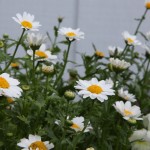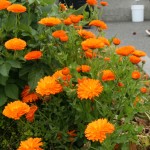
Winter can be dull if we haven’t prepared for it, with the gray skies and so many plants dormant. Much as I am a fan of shrubs and low-maintenance perennials, annuals can be a fantastic way of filling in the time between fall dormancy and spring with sparks of cheery color.
You can set out annuals between dormant perennials, or fill pots to overflowing with bright bodacious color. You can even move pots into your landscape and allow them to act as anchor points for the winter garden. When using a pot within a garden bed, I like to make sure it is big, makes a bold statement (so fill it with lots of just one or two things!), and is placed close to some larger evergreen shrubs to help it fit into the surroundings.

During the growing season, I’m often attracted to cooler colors and classy combinations, but after a couple months of clouds, I start craving those bright yellows and oranges! So keep in mind when planning your colors that the skies will have a dulling effect on your color choices – go just a bit bolder than you would in summer!
Early fall is a great time to get your winter-blooming annuals going, because if they get growing before the weather gets foul, they’ll perform a lot better through the cold months. If you are going to plant six-packs, get them in the ground in September so they have time to fill in. In October and beyond, go for the 4″ size.

Some annuals to plant now for early and mid- winter color:
- Dianthus, in sun or part shade – great in shades of magenta, pink, and white.
- Violas or Pansies, in sun or part shade (I find Violas do better through the rainy months – here, the large Pansy blooms tend to mold).
- Paludosum Daisies, in sun – I love these little white daisies; they are great with yellow Calendulas or Violas that have both yellow and either purple or blue on each flower.
- Begonias, (the bedding Begonias with petite flowers, not the tuberous Begonias with the huge honkin’ flowers), in sun or part shade (these are only reliably good till it freezes, so put them in a more sheltered spot for longer bloom).
- Calendulas, in sun – I think Calendulas are pretty gaudy in the summer, but in the winter when everything is dingy and grey? I just crave those warm colors! You can get these in yellow, orange, and some shades in between – I might go so far as to call the pale yellows and creams classy for all times of the year!
- Swiss Chard, in sun – I like the Bright Lights variety so you get all those fun-colored midribs.
- Lobelia, in sun to part shade – we all know about the deep blue ones, but don’t forget there are cute lilac-colored ones, whites, and white with blue – they are a lot better than Bacopa or other flowering trailers at this time of year since they don’t implode at the first signs of coolness.
Annuals to plant in the coming months for late winter and early spring color:
- Ornamental Kales and Cabbages in sun – yeah, so they’re kinda frilly, and I don’t do frilly – and yeah, they stink – but hey, that’s a heck of a lot of cheer at just the times when things are the dullest. I like to use them with a smattering of flower color and a bold burst of other foliage interest.
- Primroses, in part shade to bright shade – the old standby for winter and spring color – they feel so gaudy and goofy when they come into the nursery, but by January, that glow of bright color is just what I’m craving. I love that they come in flats that have a bazillion colors, so you can just choose whatever color goes with your plantings. It’s fun to experiment with some of the oranges and reds when you have things that turn orangey-bronze in winter elsewhere in the bed, or the cool blues with yellow centers if you have yellow calendulas elsewhere.

Winter-Blooming Primroses
Let’s not forget the excellent Fall-blooming Crocus, Crocus sativus. These lovely beauties won’t make you wait till spring to bloom, and their glowing purple color goes gorgeously with orange calendula, anything with purple foliage, and fresh white paludosum daisies. I’ve seen them used beautifully in a stand of Dwarf Mondo Grass – or if you are feeling bold, intersperse them with Black Mondo Grass for a glowing fall show!
Hopefully that gives you guys some good ideas to get started with for some fall container and annual planting. Tune in over the coming weeks for more ideas on how to make the most of fall planting time without having to wait endlessly for the gorgeous results of your labor.
6 responses to “Winter-Blooming Annuals to Help Your Garden Shine”
[…] Winter-Blooming Annuals to Help Your Garden Shine […]
“they are a lot better than Bacopa or other flowering trailers at this time of year since they don’t implode at the first signs of coolness”
Hmm, I wonder if that’s what happened to my Bacopa? I had trained it over a sphere topiary form and then one day, half of it just up and died. I didn’t do anything different with watering or fertilizing. There was no sign of insects, fungus or anything. Just shriveled up leaves.
Fern’s last blog post..Great Herb Window Box Advice
[…] Winter-Blooming Annuals to Help Your Garden Shine: Gen has some great tips for how to use winter-blooming annuals and also some plant recommendations. I think she is right that you can get away with guadier flowers in Winter and early Spring than you can the rest of the year. It’s been so foggy in my neck of the woods, stuff with really bright flowers or foliage really grabs your attention (in a nice way). […]
Bacopa can be vexing that way! They do fabulously well for the most part, but when they go they do it spectacularly! I definitely use them as annuals, though they are rather ambitiously housed in the Premium Perennials section of my local nurseries.
I am betting your bacopa got a stem damaged – your kitties could have done it easily. Bacopa do have brittle stems when they’ve been going for a while, and I’ve inadvertantly broken off stems while trying to do a quick nip and pinch to control size.
That makes the most sense, since if it was water (oh my gosh do they die quick from lack of water!) the whole thing would have shriveled – cold, the same thing – all the outer bits would have gone, not just half.
I’ve never heard of training them on a topiary form! That’s creative! I bet it looked pretty darn cool until that happened.
Hmmm, they could have had damaged stems. My neighbors or I could have easily banged against against the plant. You can see a pic of the dead topiary’s twin here.
[…] Winter-Blooming Annuals for the Pacific Northwest […]